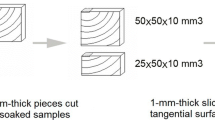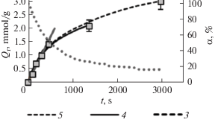Abstract
The heat affected zones (HAZ) at laser cut and laser joint wooden material surfaces were characterised measuring the temperature profile of the process within the cut kerf of particleboard and plywood, as well as the HAZ of the CO2 laser cut and Nd:YAG laser joint pine (Pinus sylvestris L.) surface using microscopy, UV microspectrophotometry and pyrolysis-GC/MS.
The width of the HAZ can be selectively modified within the range of 14–70 μm. The HAZ systematically depends on the material and process parameters, such as earlywood or latewood fibre, cut direction and laser energy per section. The thermal induced changes in wood composition were analysed for lignins and carbohydrates. The chemical and structural modifications seem to be most intense at the laser treated surface and decreases to levelling off at 35–40 μm distance from the surface.
Zusammenfassung
Die Wärmeeinflusszone (WEZ) von mit Laserstrahlung getrennten und gefügten Werkstoffen aus Holz wurde thermographisch, mikroskopisch und topochemisch untersucht. Die Charakterisierung erfolgte anhand der Temperaturprofile im Schnittspalt des Laserschneidens von Spanplatte und Sperrholz sowie durch Analyse der WEZ von mit CO2-Laserstrahlung getrenntem bzw. mit Nd:YAG-Laserstrahlung gefügtem Kiefernholz (Pinus sylvestris L.) mittels Mikroskopie, UV-Mikrospektralphotometrie und Pyrolyse-GC/MS.
Die Breite der WEZ kann im Bereich von 14–70 μm gezielt beeinflusst werden. Sie hängt systematisch von den Werkstoff- und Prozessparametern, wie Frühholz- bzw. Spätholzanteil, Vorschub- bzw. Faserrichtung und der Laser-Streckenenergie ab. Die thermisch induzierte Modifikation des Holzes wurde anhand von Lignin bzw. Ligninderivaten und Kohlenhydraten analysiert. Die stärkste Modifikation kann an der laserbehandelten Oberfläche beobachtet werden; sie nimmt stetig bis zur Entfernung von 35–40 μm von der Oberfläche ab.
Similar content being viewed by others
References
Arai T, Kawasumi H, Hayashi D (1976) Study on laser machining of wood. Measurement and observation of heat affected zone. J Jap Wood Res Soc 22:655–660
Arai T, Kawasumi H, Hayashi D (1977) Thermal analysis of laser machining of wood. I. Estimation of temperature rise induced by laser beam, judged from the in direct measurement of reaction rate. J Jap Wood Res Soc 25:543–548
Arai T, Kawasumi H, Hayashi D (1977) Studies on Laser Machining of Wood. Mokuzai Gakkaishi 23(7):317–321
Barcikowski S, Bunte J, Haferkamp H (2000) Safety first: Sicherheits- und Optimierungsaspekte lasergestützter Bearbeitung von Furnier und Birkensperrholz. Furniermagazin 2000:18–23
Barcikowski S, Goede M, Ostendorf A (2002) Putting fundamentals on multiphase material balance of laser based cutting of polymers and natural fibre composites to practical use. Contribution to High Power Macro Processing HPL2002 Symposium at LAMP 2002 Osaka Japan
Barcikowski S (2004) Laserstrahltrennen von Werkstoffen aus Holz. VDI-Fortschrittsberichte Reihe 5(695):44
Barcikowski S, Bunte J, Ostendorf A (2004) Laser cutting of wood and wood composites – evaluation of cut quality and comparison to conventional wood cutting techniques. Proc of PICALO 2004, Paper No 417 (in press)
Boon JJ, Pouwels AD, Eijkel GB (1987) Pyrolisis high-resolution gas chromatographymass spectrometry studies on beech wood: capillary high-resolution mass spectrometry of a beech lignin fraction. Biochem Soc Trans, 618th meeting 15:170–174
Faix O, Meier D, Grobe I (1987) Studies on isolated lignins in woody materials by pyrolysis-gas chromatography-mass spectrometry and off-line pyrolysis-gas chromatography with flame ionization detection. J Anal Appl Pyrol 11:403–416
Faix O, Fortmann I, Bremer J, Meier D (1996) Thermal degradation products of wood – Gas chomatographie separations and mass spectrometric characterization of polysaccharide derived products. Holz Roh- Werkst 49:213–219
Faix O, Fortmann I, Bremer J, Meier D (1996) Thermal degradation products of wood – A collection of electron impact (El) mass spectra of polysaccharide derived products. Holz Roh- Werkst 49:299–304
Fengel D, Wegener G (1989) Wood Chemistry, Ultrastructure, Reactions. Walter de Gruyter, Berlin New York
Fergus BJ, Procter AR, Scott JAN, Goring DAI (1969) The distribution of lignin in sprucewood as determined by ultraviolet microscopy. Wood Sci Technol 3:117–138
Fergus BJ, Goring DAI (1970) The location of guaiacyl and syringyl lignins in birch xylem tissue. Holzforschung 24:113–117
Forstrom D (1993) An update on laser diemaking systems, DDIN North America, 33
Galletti GC, Bocchini P (1995) Pyrolisis/gas chromatography/mass spectrometry of lingocellulose. Mass Spectrom 9:815–826
Goldschmid O (1971) Ultraviolet spectra. In: Sarkanen KV, Ludwig CH (eds) Lignins, Occurance, Formation, Structure and Reactions. Wiley Interscience, New York, pp 241–246
Haferkamp H, von Busse A, Thürk O, Goede M (2001) Welding of Automotive Polymeric Components Using Laser Radiation. In: Proc of ATTCE 2001 3:51–57
Haferkamp H, Sattari R, Barcikowski S, Herzog D, Bunte J (2003) Laser Transmission Welding of Thermoplastic Polymers and Wood Composites. NoLamp
Haferkamp H, von Busse A, Barcikowski S, Bunte J (2003) Welding of polymer and wood composites using laser radiation. In: Proc of 22nd ICALEO, pp 291–301
Haller P, Wust H (2002) Schonende Oberflächenbehandlung von Holz durch Laser. Laser Mag 3:36
Herzog D, Barcikowski S, Fargas M, Hustedt M, Sattari R (2004) Laser Welding of Wood and Natural Fibre Composites with Thermoplastics. In: Proc of 5th Global Wood and Natural Fibre Composites Symposium, pp B16 ff
Izumi A, Kuroda K, Ohi H, Yamaguchi A (1995) Structural analysis of lignin by pyrolysis-gas chromatography. (III). Comparative studies of pyrolysis – gas chromatography and nitrobenzene oxidation for the determination method of lignin composition in hard wood. Kami Pa Gikyoshi 49(9):1339–1346
Koch G, Kleist G (2001) Application of scanning UV microspectrophotometry to localise lignins and phenolic extractives in plant cell walls. Holzforschung 55:563–567
Kuroda K, Inoue Y, Sakai K (1990) Analysis of lignin by pyrolysis-gas chromatography – Effect of inorganic substances on guaiacol derivative yield from softwoods and their lignins. J Anal Appl Pyrol 18:59–69
Kürschner K, Melcerová A (1965) Über die chemischen Veränderungen des Buchenholzes bei thermischer Behandlung, Teil II, Chemische Veränderungen von Buchenholzkanteln bei 1–2 tägiger Erhitzung auf 80–130 °C unter besonderer Berücksichtigung der UV-Absorptionsspektren. Holzforschung 6:161–178
Lange PW (1954) The distribution of the components in the plant cell wall. Svensk Papperstidn 57:563–567
Neèesaný V, Kleskeòová M, Orech T (1979) Veränderungen der Holzstruktur durch Laserstrahlung I. Devársky Výskum (wood research) 24:19–27
Neèesaný V, Kleskeòová M, Orech T (1979) Veränderungen der Holzstruktur durch Laserstrahlung II. Devársky Výskum (wood research) 24:29–42
Nimz H (1973) Chemistry of potential chromophoric groups in beech lignin. Tappi J 56:124–126
Parameswaran N (1982) Feinstrukturelle Veränderungen an durch Laserstrahl getrennten Schnittflächen von Holz und Holzwerkstoffen. Holz Roh- Werkst 40:421–428
Pouwels AD, Boon JJ (1990) Analysis of beech wood samples, its milled wood lignin and polysaccharide fractions by Curie-point and Platinum Filament Pyrolysis-Mass Spectrometry. J Anal Appl Pyrol 17:97–126
Pouwels AD, Tom A, Eijkel GB, Boon JJ (1987) Characterisation of beech wood and its holocellulose and xylan fractions by pyrolysis-gas chromatography-mass spectrometry. J Anal Appl Pyrol 11:417–436
Ready JF, Farson DF (2001) LIA handbook of laser materials processing. 1st edition. Magnolia Publishing, Inc, Orlando, pp 456–459
Schulten S, Krause F, Grosser U (2001) Lasergeschweisster Luftsammler – Polyamidsystem für anspruchsvolle Schweissverfahren in der Serienproduktion. Tech Kunstst 91(7):100–102
Spurr AR (1969) A low viscosity epoxy resin embedding medium for electron microscopy. J Ultrastruct Res 26:31–43
Author information
Authors and Affiliations
Corresponding author
Rights and permissions
About this article
Cite this article
Barcikowski, S., Koch, G. & Odermatt, J. Characterisation and modification of the heat affected zone during laser material processing of wood and wood composites. Holz Roh Werkst 64, 94–103 (2006). https://doi.org/10.1007/s00107-005-0028-1
Published:
Issue Date:
DOI: https://doi.org/10.1007/s00107-005-0028-1




